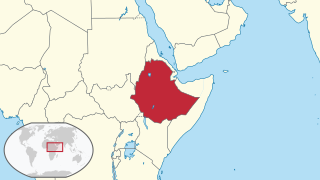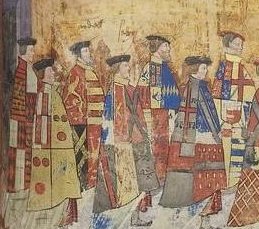
Year 1542 (MDXLII) was a common year starting on Sunday of the Julian calendar.

James IV was King of Scotland from 11 June 1488 until his death in battle in 1513. He assumed the throne following the death of his father King James III at the Battle of Sauchieburn, a rebellion in which the younger James played an indirect role. He is generally regarded as the most successful of the Stewart monarchs of Scotland, but his reign ended in a disastrous defeat at the Battle of Flodden. He was the last monarch from Great Britain to be killed in battle.

Henry Grace à Dieu, also known as Great Harry, was an English carrack or "great ship" of the King's Fleet in the 16th century, and in her day the largest warship in the world. Contemporary with Mary Rose, Henry Grace à Dieu was even larger, and served as Henry VIII's flagship. Built by William Bond under the direction of Robert Brygandine, she had a large forecastle four decks high, and a stern castle two decks high. She was 165 feet (50 m) long, measuring 1,000 tons burthen and having a complement of 700 men. She was ordered by Henry VIII, probably to replace Grace Dieu, which had been destroyed at the Battle of Saint-Mathieu in August 1512, and at a time of naval rivalry with the Kingdom of Scotland, her size was in response to the Scottish ship Great Michael, which had herself been the largest warship when launched in 1511.

Thomas Howard, 2nd Duke of Norfolk, styled Earl of Surrey from 1483 to 1485 and again from 1489 to 1514, was an English nobleman, soldier and statesman who served four monarchs. He was the eldest son of John Howard, 1st Duke of Norfolk, by his first wife, Catharina de Moleyns. The Duke was the grandfather of both Queen Anne Boleyn and Queen Catherine Howard and the great-grandfather of Queen Elizabeth I. In 1513 he led the English to victory over the Scots at the decisive Battle of Flodden, for which he was richly rewarded by King Henry VIII, then away in France.

The Battle of Flodden, Flodden Field, or occasionally Branxton, was a battle fought on 9 September 1513 during the War of the League of Cambrai between the Kingdom of England and the Kingdom of Scotland, resulting in an English victory. The battle was fought near Branxton in the county of Northumberland in northern England, between an invading Scots army under King James IV and an English army commanded by the Earl of Surrey. In terms of troop numbers, it was the largest battle fought between the two kingdoms.

Airth is a Royal Burgh, village, former trading port and civil parish in Falkirk, Scotland. It is 8 miles north of Falkirk town and sits on the banks of the River Forth. Airth lies on the A905 road between Grangemouth and Stirling and is overlooked by Airth Castle; the village retains two market crosses and a small number of historic houses. At the time of the 2001 census the village had a population of 1,273 residents but this has been revised to 1,660 according to a 2008 estimate.
Sir Andrew Barton was a Scottish sailor from Leith. He gained notoriety as a privateer, making raids against Portuguese ships. He was killed in battle and memorialised in English and Scottish folk songs.

The Royal Scots Navy was the navy of the Kingdom of Scotland from its origins in the Middle Ages until its merger with the Kingdom of England's Royal Navy per the Acts of Union 1707. There are mentions in Medieval records of fleets commanded by Scottish kings in the twelfth and thirteenth centuries. King Robert I, developed naval power to counter the English in the Wars of Independence (1296–1328), and after the establishment of Scottish independence continued to build up naval capacity. In the late fourteenth century naval warfare with England was conducted largely by hired Scots, Flemish and French merchantmen and privateers. King James I, took a greater interest in naval power establishing a shipbuilding yard at Leith and probably created the office of Lord High Admiral.

Michael, popularly known as Great Michael, was a carrack or great ship of the Royal Scottish Navy. She was the largest ship built by King James IV of Scotland as part of his policy of building a strong Scottish navy.

Gaston de Foix, duc de Nemours, byname The Thunderbolt of Italy, was a famed French military commander of the Renaissance. Nephew of King Louis XII of France and general of his armies in Italy from 1511 to 1512, he is noted for his outstanding military feats in a career which lasted no longer than a few months. The young general is regarded as a stellar commander well ahead of his time. An adept of lightning fast forced marches as well as sudden and bold offensives that destabilized contemporary armies and commanders, De Foix is mostly remembered for his brilliant six-month campaign against the Holy League in the War of the League of Cambrai. He met his end in said conflict, at the age of 21, during the Battle of Ravenna (1512), the last of his triumphs.

Andrew Forman was a Scottish diplomat and prelate who became Bishop of Moray in 1501, Archbishop of Bourges in France, in 1513, Archbishop of St Andrews in 1514 as well as being Commendator of several monasteries.

The Anglo-Scottish Wars comprise the various battles which continued to be fought between the Kingdom of England and the Kingdom of Scotland from the time of the Wars of Independence in the early 14th century through to the latter years of the 16th century.

Alexander Stewart was an illegitimate son of King James IV of Scotland by his mistress Marion Boyd. He was the King's eldest illegitimate child. He was an elder brother of Catherine Stewart, his only full sibling, a half brother to James Stewart, Margaret Stewart and Janet Stewart, the other illegitimate children of James IV and his mistresses. He was an older half-brother of the future James V.

Sir Edward Howard, KG was an English naval officer. He was the first of the Howards to win fame as an admiral, participating in his first naval battle while in his teens. He was in command during the Battle of Saint-Mathieu, which may have been the first sea battle fought by ships with cannons deployed through ports. He was killed shortly afterwards, leading an assault on galleys in the French fleet near Brest.
James Stewart, 1st Earl of Buchan (1442–1499) was a Scottish noble. He was the uncle of James III of Scotland who granted him the Earldom of Buchan. Buchan repaid his nephew by fighting for his cause against rebellious southern barons. Through his marriage to Margaret Ogilvy he acquired the title Lord Auchterhouse.

Henry Courtenay, 1st Marquess of Exeter, 2nd Earl of Devon, KG, PC, feudal baron of Okehampton, feudal baron of Plympton, of Tiverton Castle, Okehampton Castle and Colcombe Castle all in Devon, was a grandson of King Edward IV, nephew of the queen consort, Elizabeth of York and a first cousin of King Henry VIII. Henry Courtenay was a close friend of Henry VIII's, having "been brought up of a child with his grace in his chamber."
Margaret was a Scottish warship of the 16th century.
Events from the 1510s in England.
Alexander Gordon, 3rd Earl of Huntly was a Scottish nobleman. He was a member of Parliament, a member of the Privy Council, a regent and Lieutenant of the kingdom.
Vlad V cel Tânăr was the Prince of Wallachia (1510–1512). He took the throne from Mircea III Dracul on 8 April 1510 with the help of the Ottomans and with the support of the Craiovești family. In exchange, the prince vowed protection to Mehmet and his family and Parvu Craiovescu, a member of the Craiovești family, became the head of the Divan of Wallachia. Parvu was then followed by Danciu and in 1511, by Bogdan, the Prince's brother-in-law.